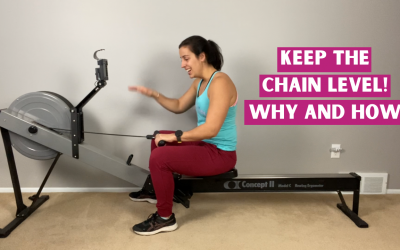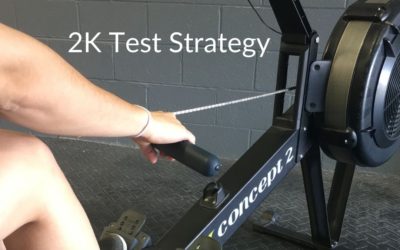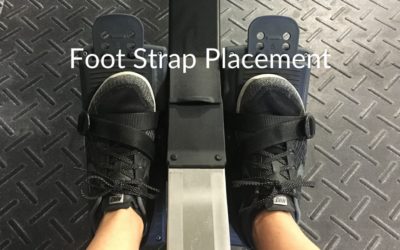Beginner’s Guide to Indoor Rowing
Getting a new workout machine is much like getting a new toy on Christmas. There’s so much excitement and anticipation to try it out! Many times we play with that new toy for a couple of days, and then it’s out of sight and out of mind.
My guess is that’s not how you want it to go with your new rowing machine. Rowing is such a great workout, and you don’t want it to get old that quickly.
Or maybe you’re looking at trying that rowing machine in the gym that you’ve seen but you’re not sure where to start.
In both scenarios, it can be overwhelming when you sit down on that machine and see so many numbers on the screen. And then there’s having good form because the last thing you want to do is hurt yourself.
Here is a little guide (with lots of links) to helpful posts to get you started. Some posts are Concept2 specific, but once you get into the rowing form, it applies no matter the machine you have.
LEARNING THE MONITOR
Setting up the machine means getting started with the monitor. First, you’ll want to take note of the different information it’s telling you.
My specialty is Concept2 machines, but there are plenty of other rowing machines out there. They will vary on what information they show you. Typically it will show some sort of distance measurement, power measurement, and/or time measurement.
For example, the Concept2 machines have multiple kinds of units, but the one used most often is the split per 500m pace. This split shows the time it would take to row 500m at that power output. For some machines it may show meters, the number of strokes, watts, mileage, or any host of different units. Take some time to see what your monitor displays, and take some easy strokes to see how the numbers change based on how hard you row.
If you want more information on the data shown on the Concept2 monitor, check out this post: Navigating and Understanding the Indoor Rowing Monitor.
Some machines may have the ability to program workouts into the monitor. If you have a Concept2, check out this post on How to Set Up a Rowing Workout.
BEFORE YOU ROW
Why yes, there are other settings to make sure you have set before you start rowing.
First, you want to check your damper setting. For Concept2, the machines use a damper setting on the side of the flywheel. This should be set somewhere between 3 and 5. Other machines may have a different way of establishing how much pull there is on the handle. For more info on this, check out the post Where to Set Your Damper for Rowing Workouts.
For water rowers, there’s no specific “resistance” setting. In order to change how the stroke feels, you can increase or decrease the amount of water in the tank. More water in the tank simulates a heavier “boat” which makes the rowing stroke more of a strength workout than cardio. Play around with the tank level to where you have something to push against but are able to keep the flywheel moving.
Next, you want to check your foot strap placement. For most machines, you want the foot strap to be over the widest part of your shoe, or slightly higher. For more info on this, check out this post Foot Strap Placement.
Speaking of the foot straps, if you’re going to be doing rowing workouts where you’ll be getting on and off the machine, then you are going to want to know the quickest and safest way to do that. To see how it’s done, check out this post Getting On and Off the Rower Quickly.
Lastly, it’s important to take note of how you’re sitting on the seat. Ideally, we want our sit bones to go down into the seat. To know what I’m talking about here, check out this great video done by Master Instructor Cassi Neiman from UCanRow2 here.
LEARNING FORM
It’s important to learn good form when you’re just starting out. There are different aspects to the rowing stroke that, if done incorrectly, can cause injuries over time.
I have quite a few posts here going over drills you can do, as well as other kinds of technique posts. Here are some you can check out:
No Results Found
The page you requested could not be found. Try refining your search, or use the navigation above to locate the post.
There are also other places to find good technique advice. The two I recommend are UCanRow2 and Dark Horse.
Here is a link to a great YouTube video done by Master Instructor Cassi that introduces good rowing form (click here). UCanRow2 also has other technique videos on their YouTube channel. They are worth checking out!
Dark Horse is another great resource. Here is a link to their Learn to Row Workout playlist on YouTube.
Once you’ve used some free resources to learn, get on the rowing machine and practice that good form! Don’t worry about pulling hard quite yet. Get comfortable with good rowing first.
Pro tip: focus on one thing at a time. A technique video may mention multiple things you could work on, but pick on and focus on it for a couple of minutes. After you take a short break, maybe tackle something else to workout. Trying to focus on 3+ things will overload your brain and have you exhausted before you even start!
Once you’ve had some time to practice, I highly recommend getting one on one personal help from a certified coach. A coach is going to have that eye to know what you personally need to work on to get that rowing stroke where it needs to be.
I personally do 30 min Zoom sessions to go over technique in the rowing stroke. Head on over to this page if you’re interested.
WORKOUTS
Now that you’ve worked on your form for a little bit, now you can start getting into some workouts.
Even when working on technique, I advise starting with a couple of minutes at a time (3-5 min), taking a short break (~1 min), and repeating this until you’re ready to be done. As you row more, you may be able to repeat that more times.
As those intervals start to get easier, you can start making them longer (5-8 min) with short breaks. Then increase the length you’re rowing again once you’re comfortable. Working your way up to about 20 minutes of rowing nonstop.
Once you can row for about 20 minutes without stopping, you’re ready to check out some other workouts! Dark Horse, as mentioned above, has some other follow along with workouts you could try.
Here’s another resource for a couple of rowing plans and classes to get you started. I highly recommend the classes and programs by UCanRow2. Their master instructors are highly qualified and great at coaching. I have included some other options where I have seen good rowing.
When choosing an instructor and class, you’ll want to make sure the instructor is certified. Make sure THEY row well based on the technique videos you’ve seen. A good rowing instructor and class will focus on technique throughout and still be able to push you.
| Resource | What is it? | Price |
| RowReady | Beginner Rowing plan with follow along style technique videos | $97 or 3 payments of $33 |
| Beginner Pete Plan | Beginner rowing plan to increase endurance on the rowing machine | Free |
| UCanRow2 Classes | Live online classes | $12 per class |
| Row House Go | Video Workouts | $19 per month |
| Live2Row Studios | Live classes | Free 2 week trial. $35 per month or $7 per class |
| Workout Video library | $20 per month | |
| Asensei | Interactive follow along workout videos | $12.50 per month billed annually |
OTHER HELPFUL INFO
When you’re done working out, it’s important to clean your rowing machine! You’ll want to wipe down the seat, handle, buttons, and monorail. Don’t use abrasive cleaners on the monorail though, and never spray the monitor! Every so often you want to oil the chain and clean out the flywheel as well. For more info on cleaning your machine, check out this post Cleaning Your Concept2 Rower.
If you’re struggling with establish a workout routine, check out this post 5 Tips for Establishing a Workout Routine.
Lastly, I don’t recommend getting carried away and making it a goal to row every single day. Taking rest days is healthy! If you’re unsure if you need a rest day, or might need an extra rest day, check out this post 5 Signs You Need a Rest Day.
There’s a lot to learn about indoor rowing, and this is by no means an exhaustive list. Use this guide to get started, and everything else will come with time.
Keeping the Chain Level
You may have heard that in your rowing stroke, it's important to keep that chain level throughout your entire rowing stroke. Here, I'm going to teach you why it's important and why keeping that chain level can affect other parts of your stroke and make you a better...
2K Test Strategy
“I can’t wait for 2K test day!” said no one ever. This test piece is one that can make even the most experienced rower dread the workout that day. So, if you are one of those people who avoid the gym when you see that a 2000m piece is posted as the workout, you are...
Foot Strap Placement
The placement of the foot straps on your shoes can be just as important as anything else in your rowing stroke. In fact, having proper foot placement could fix any technical issues you may not be aware of. When you change where your foot sits, it affects the angle of...



